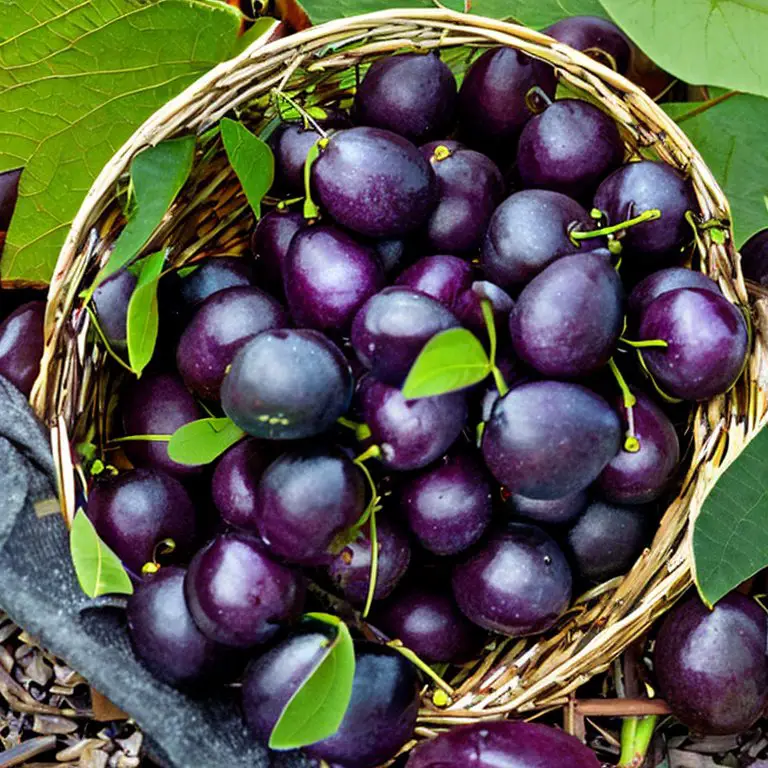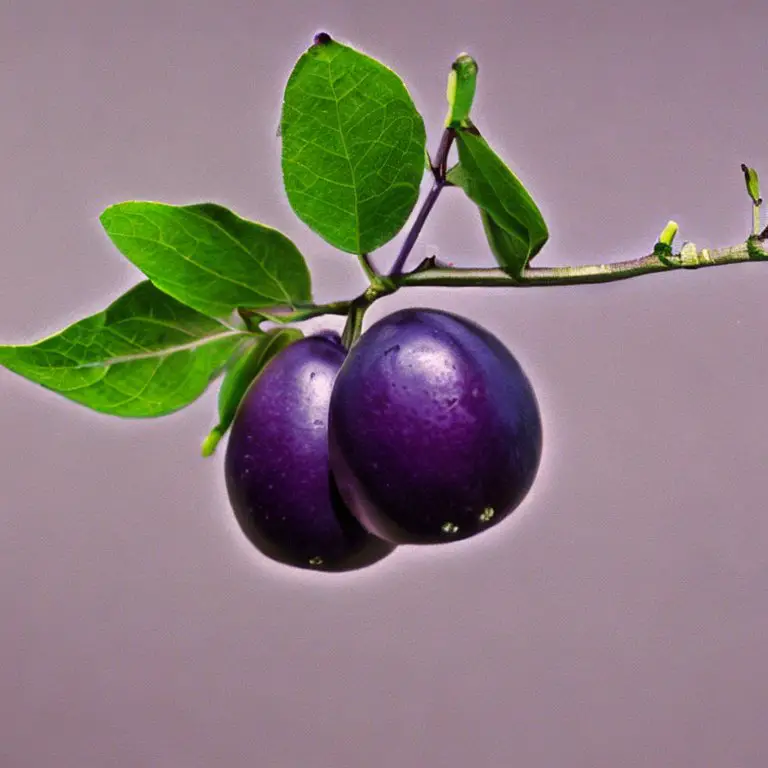
The blue damson plum is a tiny, sour fruit native to Asia and Europe that is similar to a plum. In this post, we will explore the damson plum and the most common things to know about this fruit!
Contents

- What is a Damson Plum?
- Damson Plum Tree
- Damson Plum Growing Zone
- Blue Damson Plum Taste
- What Does a Damson Plum Look Like?
- Damson Plum Benefits
- Damson Plum Nutrition
- Blue Damson Plum Recipes
- Damson Fruit Size
- Damson vs Plum
- Where to Buy Damson Plums
What is a Damson Plum?
The damson, a type of plum belonging to the Prunus genus, shares ancestry with cherries, peaches, and plums. Its roots trace back to Western Asia and Europe, where for thousands of years, people have savored the juicy, flavorful fruit, and it has a long history of use in cooking and preserving. The fruit is typically purple or blue in color and has a unique, slightly bitter flavor that sets it apart from other types of plums.
Blue Damson plums are often used in jams, jellies, and other preserves, and can also be cooked into pies, tarts, and other desserts. They are particularly popular in Britain, where they are often used to make a traditional dessert known as damson cheese. This dessert is similar to a fruitcake and is made by cooking the plums with sugar and spices to form a thick, spreadable paste.
In addition to their culinary uses, damson plums have also been used for their medicinal properties. The fruit and its leaves have been used to treat a variety of conditions, including digestive problems, sore throats, and respiratory infections. Some people also believe that damson plums can help to boost the immune system and improve overall health.

Despite their long history and many uses, damson plums are not as widely known or appreciated as other types of plums. This is partly because they are more difficult to grow and harvest than other plums, and their tart flavor is not to everyone’s taste. However, for those who enjoy their unique flavor and versatility, damson plums are a delicious and nutritious addition to any diet.
In terms of their nutritional value, damson plums are a good source of fiber, vitamins, and minerals. They are high in antioxidants, which can help to protect the body from the damaging effects of free radicals. They also contain potassium, which is important for maintaining healthy blood pressure, and iron, which is essential for carrying oxygen throughout the body.
Damson plums are also low in calories and fat, making them a healthy choice for those who are trying to lose weight or maintain a healthy weight. They are also a good source of natural sugar, which can provide a boost of energy without causing a spike in blood sugar levels.
Despite their many benefits, there are a few potential drawbacks to consuming damson plums. As with any fruit, it’s important to eat them in moderation and avoid consuming large amounts, as they can cause digestive problems in some people. Additionally, the seeds and pits of damson plums contain small amounts of cyanide, which can be toxic if consumed in large quantities. However, this is not a concern for most people, as it would be difficult to eat enough damson plums to consume a toxic amount of cyanide.
Overall, the damson plum is a unique and flavorful fruit that has been enjoyed for thousands of years. While it may not be as well-known as other types of plums, it has many culinary and medicinal uses and can provide a variety of health benefits. It’s worth trying if you are looking for something new and different to add to your diet.
Damson Plum Tree
The Damson Plum tree that bears the damson plum is a small to medium-sized tree, reaching up to 20 feet. It boasts oval-shaped, dark green leaves and fragrant white or pink blooms in spring.
Damsons are hardy and adaptable, able to endure cold and thrive in various soil types, although they prefer well-drained soil with a pH of 6.0 to 7.0 and require full sun exposure. Winter cold is crucial for these trees to produce fruit in summer.
Beyond its commercial appeal, the damson tree is a popular ornamental, gracing home gardens and public parks with its blooms and sweet fruit. A versatile, flavorful fruit, the damson is a valuable addition to any orchard, whether grown commercially or at home.
Damson Plum Growing Zone
Damson trees flourish in temperate climates, especially in Europe and North America. In Europe, the UK, France, Italy, and Germany cultivate the damson for jellies, jams, and wine. In the UK, the fruit has a rich history, used in traditional sloe gin.
North America adopted the damson in the 1700s, with western states like California proving ideal for growth. There, it’s used in preserves, jams, baked goods, and as a fresh fruit.
Meanwhile, in Asia, China, Japan, and Korea, the damson is widely grown for jellies, jams, and wines, with China also utilizing it in traditional medicine.
Blue Damson Plum Taste
Damson plums have a unique, slightly tart flavor that sets them apart from other types of plums. The flesh of the damson plum is yellow or green in color and has a juicy, slightly tart texture.
The flavor of the damson plum is often described as being slightly sour and tangy, with a slightly bitter aftertaste. Some people find the flavor of damson plums to be too strong or bitter, while others enjoy their unique taste.
The flavor of the damson plum can vary depending on the variety and its stage of ripeness, so it’s worth trying a few different types to find one that you like. (See more at Blue Damson Plum Taste)
What Does a Damson Plum Look Like?
Damson plums are small, oval-shaped fruits that are similar in appearance to other plums. They are typically purple or blue in color and have a smooth, glossy skin that is covered in a fine white powder, known as bloom.

The fruit is typically about the size of a cherry and has a small, flat stone at its center. The flesh of the damson plum is yellow or green in color and has a juicy, slightly tart texture. The fruit is often smaller and more wrinkled than other types of plums, and its skin may be thicker and more difficult to peel. Overall, damson plums are easily recognizable by their unique color and texture.
Damson Plum Benefits
Damson fruit, also known as damson plums, are small, tart fruits that are native to Asia and Europe. They have a long history of use in cooking and preserving, and have also been used for their medicinal properties. Some of the potential benefits of consuming damson fruit include:
- Good source of fiber: Damson fruit is a good source of dietary fiber, which is important for maintaining a healthy digestive system. Consuming foods that are high in fiber can help to prevent constipation, keep your bowels regular, and improve overall digestive health.
- High in antioxidants: Damson fruit is high in antioxidants, which are compounds that can help to protect the body from the damaging effects of free radicals. Antioxidants can help to prevent cell damage and may reduce the risk of chronic diseases, such as heart disease and cancer.
- Low in calories and fat: Damson fruit is low in calories and fat, making it a healthy choice for those who are trying to lose weight or maintain a healthy weight. The natural sugar in damson fruit can provide a boost of energy without causing a spike in blood sugar levels.
- Good source of vitamins and minerals: Damson fruit is a good source of various vitamins and minerals, including potassium, iron, and vitamins A and C. Potassium is important for maintaining healthy blood pressure, while iron is essential for carrying oxygen throughout the body. Vitamins A and C are important for maintaining healthy skin, eyes, and immune function.
- May have medicinal properties: In addition to its culinary uses, damson fruit has also been used for its medicinal properties. The fruit and its leaves have been used to treat a variety of conditions, including digestive problems, sore throats, and respiratory infections. Some people also believe that damson fruit can help to boost the immune system and improve overall health.
Overall, damson fruit is a tasty and nutritious fruit that has many potential health benefits. While it may not be as well-known as other types of plums, it is worth trying if you are looking for something new and different to add to your diet.
Damson Plum Nutrition
Damson plums are a nutritious and flavorful fruit that can provide a variety of health benefits. In terms of their nutritional value, damson plums are a good source of fiber, vitamins, and minerals. They are also low in calories and fat, making them a healthy choice for those who are trying to lose weight or maintain a healthy weight.
One serving of damson plums (about 100 grams) contains the following nutrients:
- Calories: 50
- Protein: 1 gram
- Fat: 0.5 grams
- Carbohydrates: 11 grams
- Fiber: 2 grams
- Potassium: 160 milligrams
- Iron: 0.3 milligrams
- Vitamin A: 80 micrograms
- Vitamin C: 10 milligrams
Damson plums are also a good source of antioxidants, which are compounds that can help to protect the body from the damaging effects of free radicals. Antioxidants can help to prevent cell damage and may reduce the risk of chronic diseases, such as heart disease and cancer.
In addition to their nutritional value, damson plums are also low in calories and fat, making them a healthy choice for those who are trying to lose weight or maintain a healthy weight. The natural sugar in damson plums can provide a boost of energy without causing a spike in blood sugar levels.
Overall, damson plums are a nutritious and flavorful fruit that can provide a variety of health benefits. They are a good source of fiber, vitamins, and minerals, and are low in calories and fat. Adding damson plums to your diet can help to improve your overall health and well-being.
Blue Damson Plum Recipes
Damson plums are a versatile and flavorful fruit that can be used in a variety of recipes. (See Blue Damson Plum Recipes for all of our damson plum recipes) Some common damson plum recipes include:
- Damson jam: Damson plums are often used to make jam, which is a sweet, spreadable fruit preserve. To make damson jam, the plums are cooked with sugar and lemon juice until they are soft and pulpy. The mixture is then strained to remove the pits and skins, and the remaining pulp is cooked until it forms a thick, spreadable consistency. (See Easy Damon Jam Recipe)
- Damson cheese: Damson cheese is a traditional British dessert that is similar to a fruitcake. To make damson cheese, the plums are cooked with sugar and spices to form a thick, spreadable paste. The paste is then packed into a mold and left to set, forming a solid block of damson cheese that can be sliced and served.
- Damson tart: Damson plums can also be used to make a delicious tart. To make a damson tart, the plums are cooked with sugar and a little water until they are soft and pulpy. The mixture is then spooned into a pre-baked tart shell and baked until the pastry is golden and the filling is set.
- Damson sorbet: Damson plums can also be used to make a refreshing sorbet. To make damson sorbet, the plums are cooked with sugar and water until they are soft and pulpy. The mixture is then strained to remove the pits and skins, and the remaining pulp is blended with a little lemon juice and frozen until it forms a smooth, creamy sorbet.
Overall, damson plums are a versatile and flavorful fruit that can be used in a variety of sweet and savory dishes. Whether you prefer jams, tarts, sorbets, or something else entirely, there is a damson plum recipe out there that is sure to suit your taste.
Damson Fruit Size
Damson fruit, also known as damson plums, are small, oval-shaped fruits that are similar in size to cherries. The exact size of damson fruit can vary depending on the variety and its stage of ripeness, but they are typically about the size of a cherry and have a small, flat stone at their center.

Damson fruit are often smaller and more wrinkled than other types of plums, and their skin may be thicker and more difficult to peel. Despite their small size, damson fruit are packed with flavor and nutrition, and a little goes a long way in cooking and preserving.
Damson vs Plum
Damson plums and plums are both types of fruits that belong to the Prunus family, which also includes cherries, peaches, and almonds. Damson plums and plums are similar in many ways, but there are also some key differences between the two.
One of the main differences between damson plums and plums is their size and shape. Damson plums are typically smaller and rounder than plums, and they also have a more oblong or oval shape. Plums, on the other hand, are larger and more oval in shape.
Another key difference between damson plums and plums is their flavor and texture. Damson plums are known for their tart, acidic flavor, which makes them well-suited for use in cooking and baking. Plums, on the other hand, are generally sweeter and less acidic, and are often eaten fresh or used in fruit salads.
In terms of their appearance, damson plums and plums also have some differences. Damson plums typically have a deep purple or blue-black color, while plums can be a variety of colors, including yellow, red, and purple.
Overall, while damson plums and plums are similar in many ways, they also have some key differences in terms of their size, shape, flavor, and appearance. Both are delicious and versatile fruits that can be used in a variety of dishes and recipes. (Learn more at Damson vs Plum)
Where to Buy Damson Plums
Damson plums are a type of small, tart plum that is often used in cooking and baking. They can be difficult to find in some areas, but one option for buying fresh damson plums is to check with local farmers markets or specialty grocery stores. These types of venues often have a wider selection of fruits and vegetables, including less common varieties like damson plums.
Another option is to try calling local orchards or farms to see if they have damson plums available for purchase. Some orchards and farms also offer the option to pick your own fruits and vegetables, which can be a fun activity and a good way to get fresh, high-quality damson plums.
Lance has been passionate about the plant-based diet and we have been following a whole food plant-based diet for over 5 years. We focus on health, natural healing, weight management, animal rights, and the health of the planet and environment by focusing on whole plant-based foods and sustainable practices.
Learn more at the About Me page and follow on social media at the links below.






